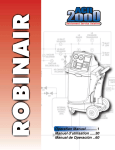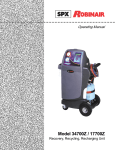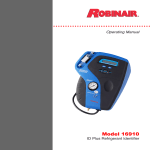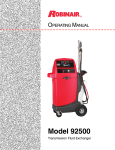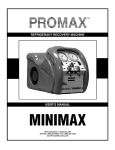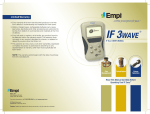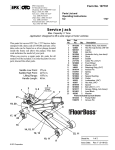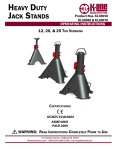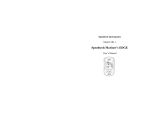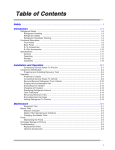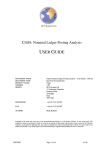Download 122247 Robinair Cover - Weber State University
Transcript
○ ○ ○ ○ ○ ○ ○ ○ ○ ○ ○ ○ ○ ○ ○ ○ ○ ○ ○ ○ ○ ○ ○ ○ ○ ○ ○ ○ ○ ○ ○ ○ ○ ○ ○ ○ ○ ○ ○ ○ ○ ○ ○ ○ ○ ○ ○ ○ ○ ○ ○ ○ ○ ○ ○ ○ ○ ○ ○ ○ ○ ○ ○ ○ ○ ○ ○ ○ ○ ○ ○ ○ ○ ○ ○ ○ ○ Operating Manual Model 342000 Refrigerant Service Solution Refrigerant: R-134a Series: 342000 Air Conditioning and Refrigerant Service Solution SAFETY DEFINITIONS: Follow all WARNING, CAUTION, IMPORTANT, and NOTE messages in this manual. These messages are defined as follows: WARNING means you may risk serious personal injury or death; CAUTION means you may risk personal injury, property damage, or serious unit damage; IMPORTANT means you may risk unit damage; and NOTEs provide clarity and helpful tips. These safety messages cover situations ROBINAIR is aware of. ROBINAIR cannot know, evaluate, and advise you as to all possible hazards. You must make sure all conditions and procedures do not jeopardize your personal safety. COPYRIGHT: No part of this manual may be reproduced, stored in a retrieval system, or transmitted in any form or by any means (electronic, mechanical, photocopy, recorded, or otherwise) without the prior written permission of ROBINAIR. DISCLAIMER: All information, illustrations, and specifications contained in this manual are based on the latest information available at the time of publication. The right is reserved to make changes at any time without obligation to notify any person or organization of such revisions or changes. Further, ROBINAIR shall not be liable for errors contained herein or for incidental or consequential damages (including lost profits) in connection with the furnishing, performance, or use of this material. If necessary, obtain additional health and safety information from the appropriate government agencies and the vehicle, refrigerant, and lubricant manufacturers. WARNINGS ALLOW ONLY QUALIFIED PERSONNEL TO OPERATE THE UNIT. Before operating the unit, read and follow the instructions and warnings in this manual. The operator must be a certified technician and must be familiar with air conditioning and refrigeration systems, refrigerants, and the dangers of pressurized components. If the operator cannot read English, operating instructions and safety precautions must be read and discussed in the operator’s native language. Si el operador no puede leer el inglés, las instrucciones de operación y las precauciones de seguridad deberán leerse y comentarse en el idioma nativo del operador. Si l’utilisateur ne peut lire l’anglais, les instructions et les consignes de sécurité doivent lui être expliquées dans sa langue maternelle. PRESSURIZED TANK CONTAINS LIQUID REFRIGERANT. Do not overfill the internal storage vessel because overfilling may cause explosion and serious personal injury or death. Do not recover or charge refrigerants into non-refillable containers; use only federally authorized refillable containers. ALL HOSES MAY CONTAIN LIQUID REFRIGERANT UNDER PRESSURE. Contact with refrigerant may cause personal injury. Wear correct protective equipment, including safety goggles. Disconnect hoses with extreme caution. HIGH VOLTAGE ELECTRICITY INSIDE THE UNIT HAS A RISK OF ELECTRICAL SHOCK. Exposure may cause personal injury. Refer to the instruction manual for correct procedure when disconnecting the power. TO REDUCE THE RISK OF FIRE, do not use the unit in the vicinity of spilled or open containers of gasoline or other flammable substances. An extension cord may overheat and cause fire. If an extension cord is needed, use the shortest possible cord with a minimum size of No. 14 AWG. DO NOT BREATHE REFRIGERANT. Exposure may cause personal injury, especially to the eyes, nose, throat, and lungs. Use this equipment in locations with mechanical ventilation that provides at least four air changes per hour or locate the equipment at least 18 inches above the floor. To remove HFC-134a from the A/C system, use service equipment certified to meet the requirements of SAE J2210 (HFC-134a recycling equipment). If accidental system discharge occurs, ventilate the work area before resuming service. R-134a USE THE UNIT WITH ONLY R-134a REFRIGERANT. The unit is for recovering, recycling, and recharging only R-134a refrigerant! Do not attempt to adapt the unit for another refrigerant. Do not mix refrigerant types through a system or in the same container; mixing of refrigerants will cause severe damage to the unit and the vehicle air conditioning system. DO NOT USE COMPRESSED AIR TO PRESSURE TEST OR LEAK TEST THE UNIT OR VEHICLE AIR CONDITIONING SYSTEM. Some mixtures of air and R-134a refrigerant are combustible at elevated pressures. These mixtures are potentially dangerous and may result in fire or explosion causing personal injury or property damage. Additional health and safety information may be obtained from refrigerant and lubricant manufacturers. This equipment is protected by one or more of the following patents: US: 4,938,031; 5,005,369; 5,248,125; 4,261,178; 4,768,347. Other U.S. and Foreign Patents Pending. Table of Contents Introduction .............................................................................................. 2 Glossary of Terms ................................................................................ 2 General Operating Guidelines .............................................................. 3 Component Location and Identification ................................................ 4 342000 Overview ...................................................................................... 6 342000 Function Keys .......................................................................... 8 Number Keys, Up/Down Arrows, Pressure Gauges ............................. 9 Set-Up Instructions ................................................................................ 10 Initial Set-Up Instructions .................................................................... 10 Power Up ............................................................................................ 12 Vehicles with Contaminated Systems ................................................. 12 Testing Source Tanks ......................................................................... 12 Operating Instructions ........................................................................... 14 Diagnosing System Operation Using Snapshot Mode ........................ 14 Snapshot Mode Operation .................................................................. 14 Recovering Refrigerant ....................................................................... 16 Making Repairs ................................................................................... 17 Pulling a Vacuum ................................................................................ 17 Replenishing A/C System Oil .............................................................. 18 Charging the Vehicle .......................................................................... 19 Flushing the A/C System .................................................................... 21 Help Screens ...................................................................................... 23 Maintenance Instructions ...................................................................... 25 Changing the Filter-Drier .................................................................... 25 Electrical Protection ........................................................................... 27 Replacing the Source Tank ................................................................ 27 Oil Time Warning ............................................................................... 28 Oil Change Menu/Process ................................................................. 28 Replacing the Printer Paper ............................................................... 28 Replacing the ID Filter ........................................................................ 29 General Maintenance ......................................................................... 29 Replacement Parts ............................................................................. 30 Warranty Information .................................................. Inside back cover 342000 Refrigerant Service Solution 1 Introduction This manual contains important safety procedures concerning the operation, use and maintenance of this product. Failure to follow the instructions contained in this manual may result in serious injury. If you are unable to understand any of the contents of this manual, please bring it to the attention of your supervisor. Do not operate this equipment unless you have read and understand the contents of this manual. The 342000 is a complete air conditioning service center for R-134a. It recovers, recycles, evacuates, and recharges refrigerant quickly, accurately and automatically, with little attention needed from the technician. A microprocessor controls the unit’s functions and prompts on the display lead you through the operation. These prompts are written so they are easy to understand and follow. The entire service procedure can be done with one hook-up to the vehicle. A built-in refrigerant identifier checks for contaminated refrigerant prior to recovery. Pressures are shown on the high and low side gauges, and other operating information is shown on the display. Refrigerant is recovered into and charged out of an internal storage vessel (ISV). The 342000 unit automatically refills this vessel with refrigerant from an external source tank as needed in order to maintain a constant 12 –15 lbs. (5.45 – 6.82 kgs) of refrigerant available to be charged. Quick connections are all that’s needed to replace the source tank when it’s empty. Other time-saving features include automatic air purge, single pass recycling, and automatic oil drain. The unit also automatically clears refrigerant after every job. A red light on the top of the unit flashes whenever a process is complete or when the unit needs attention from the user. The 342000 is UL listed and meets SAE specifications for recycled refrigerant. Glossary of Terms A/C A/C System Unit Source Tank ISV 2 Air conditioner or air conditioning The vehicle air conditioning system The refrigerant recovery/recycling/recharging unit (342000) The refrigerant source tank Internal Storage Vessel © 1999 Robinair, SPX Corporation Introduction GENERAL OPERATING GUIDELINES Use the following guidelines when operating the 342000: 1. The voltage at the unit must be ±10% of the unit’s rated voltage. Errors will be displayed on the screen. Extension cords must be a minimum of 14 AWG and kept as short as possible. Common causes for electrical problems include: • Long extension cords • Faulty, overloaded electrical circuits • Drop lights • Imcorrect ground or polarity NOTE: If your electrical circuits have reversed polarity, the screen displays the following messages: VOLTAGE LINE ERROR CHECK POLARITY VOLTAGE READOUT WILL BE DISABLED with an option to continue. NOTE: If you choose the CONTINUE option, the over- and under-voltage protection built into the circuit board will be disabled. The unit may not operate correctly. To ensure correct operation, you must use a circuit with the correct polarity. 2. The display shows options and gives instructions for most service maintenance tasks. Read the display prompts and follow the directions given there. 3. To interrupt any function, press the PAUSE key, then press the CONTINUE key to restart the procedure. 4. The 342000 prompts you to check the system oil drain bottle on the back of the unit for recovered oil. Any system oil that is lost will automatically drain during recovery. You must measure and record the lost amount so that you know how much new oil to add during charging. Refer to the A/C system manufacturer’s service manuals for oil specifications. Dispose of used oil according to local, state, and federal regulations. 5. In general, it is best to leave the 342000 main power ON throughout the workday. This allows plenty of time for the unit to purge air from the tank and refill the internal storage vessel. Turn the unit OFF at the end of the day. IMPORTANT OPERATING NOTES • • Change the filter-drier when the display shows the CHANGE FILTER message. Follow the instructions for the changeover. At temperatures exceeding 120oF / 49oC, wait 10 minutes between recovery jobs. 342000 Refrigerant Service Solution 3 Introduction COMPONENT LOCATION AND IDENTIFICATION 342000 CONTROL PANEL Low Side Gauge High Side Gauge Display Function Keys Numeric Keys Refrigerant Identifier Filter Main Power Switch Printer Arrow Keys Display Contrast Keys INST 0684 4 © 1999 Robinair, SPX Corporation Introduction COMPONENT LOCATION AND IDENTIFICATION 342000 FRONT VIEW Control Panel “Cycle Complete” Red Indicator Light Convenient Built-in Handle and Hose Storage Shelf for tools and accessories Oil Injection Bottle Filter-Drier Access Oil Drain Bottle Polypropylene Cabinet for durability and light weight INST 0685 Large Wheels for mobility across air lines, power cords, grates Locking Casters 342000 SIDE VIEW Convenient Handle for moving unit Vacuum Pump Oil Level Sight Glass and Oil Fill Port Oil Drain Bottle High Side and Low Side Hoses with Field Service Couplers, color coded Power Cord Source Tank (disposable, inverted) Tank Strap to secure tank to unit Shelf for Source Tank Source Tank Hose INST 0686 342000 Refrigerant Service Solution 5 Introduction 342000 OVERVIEW Before you begin any procedure, familiarize yourself with its functions, the components of the unit (see diagrams in this section) and its operation. 1. POWER UP—When the power is turned ON, the unit performs selfdiagnostics. When tests are complete, the display shows SELECT OPERATION. Use the function keys (F-1 to F-5) to select the desired operating mode. 2. MAIN MENU—Shows the amount of refrigerant available for charging, the current temperature, humidity, date, time, inlet valve status, and operational status. The information appears in the upper corners of the display. Use the function keys (F-1 to F-5) to select the mode or press SCROLL MENU for more choices. 3. SNAPSHOT MODE—Displays operating data about the vehicle’s A/C system, including refrigerant purity, system pressure, A/C outlet temperature; also A/C outlet air velocity with optional anemometer attachment. 4. RECOVER MODE—Removes refrigerant from the A/C system and filters it during recovery for reuse. 5. VACUUM MODE—Evacuates air from the A/C system. 6. CHARGE MODE—Recharges the A/C system; charge amount can be entered into pounds and hundredths of a pound, pounds and ounces, or kilograms. 7. HOSE RECOVER MODE—Removes all excess refrigerant from the hoses. 8. FLUSH MODE—Clears oil from the A/C system by reversing the flow of refrigerant, then filters out the contaminants. 9. SET-UP MODE—Allows you to configure the 342000 and run internal diagnostics. IMPORTANT: For your safety, observe all warnings and cautions printed in this manual. 6 © 1999 Robinair, SPX Corporation Introduction COMPONENT LOCATION AND IDENTIFICATION 342000 Temperature and Velocity Probes (located on back panel) Circuit Breakers Blue Temp Probe Red Temp Probe Anemometer RS232 Outlet INST0687 A/C System Close-Up of Oil Drain Connection (located on side panel near tank) Oil Drain Bottle simply snaps into place (Be sure the drain tube is inside the bottle) INST0688 342000 Refrigerant Service Solution 7 Introduction FUNCTION KEYS The function keys (F-1 to F-5) change depending on the service operation and the unit’s status. The display shows five labels along the bottom with arrows pointing to the function keys below. Each label shows what action a particular function key will activate. To make a selection, press the function key immediately below the label/arrow. This display is not a touch screen—you must press the key. As an example, the last label in the illustration shows SCROLL MENU. To see what other options are available, press the key immediately below SCROLL MENU (F-5) to go to another menu. All five keys are not always active. Follow the labels on the display. There is always a selection for MAIN MENU. Keypad and Function Keys TEMP. 70OF HUMIDITY 58% VOLTAGE : 115 VAC HIGH: 13" Hg 24-Jun-1999 8:09 AM CHARGEABLE 7.30 lbs. Low: 7" Hg MAIN MENU SELECT OPERATION Display & Prompts Vacuum Charge Snapshot Scroll Menu F1 F2 F3 F4 F5 1 2 3 4 5 6 7 8 9 0 Main Menu shown with sample messages 8 p p UP/DOWN RIGHT/LEFT Arrow Keys Recover Function Choices Function Keys Contrast Darker Contrast Lighter © 1999 Robinair, SPX Corporation Introduction Set NUMBER KEYS Use these keys to change the evacuation time, vacuum level, or recharge weight if you want an amount different than the default one shown on the display. These keys are also used to enter other numeric values, such as your area’s elevation above sea level. UP/DOWN AND LEFT/RIGHT ARROW KEYS Pressing the UP/DOWN and RIGHT/LEFT keys moves the cursor on the screen in that direction (Up, Down, Right, or Left). In addition, during numeric programming, pressing the UP arrow increases the number. Pressing the DOWN arrow decreases the number. PRESSURE GAUGES Both the high and low side gauges are equipped with red "follower" needles to show the maximum and the minimum pressures reached during operation. The follower is carried with the pressure gauge to the highest or lowest operating pressure and stays there when the regular needle indicates other pressures. 1. The follower on the low side gauge should be adjusted so it rests on the bottom side of the black needle when the A/C system is not in operation. 2. The follower on the high side gauge should be adjusted so it rests on the top side of the black needle when the A/C system is not in operation. When set up this way, the follower will be carried to the highest pressure or lowest pressure registered by the individual gauge. Low Side Pressure Indicating Needle (black) (adjust so red needle rests below the black needle) High Side Pressure Indicating Needle (black) High Side Follower Needle (red) (adjust so red needle rests above the black needle) Low Side Follower Needle (red) 342000 Refrigerant Service Solution 9 Initial Set-Up INITIAL SET-UP INSTRUCTIONS CAUTION! It is extremely important to follow these instructions! DO NOT attach any hoses or accessories until prompted by the unit. Improper set-up will result in unit failure! Use the following steps for initially setting up the 34200: 1. Attach the power cord to a 115V 60 Hz, 15 amp grounded outlet. Do not use extension cords. The unit display gives directions and explanations based on current vehicle/ service status. Read and follow these display prompts at all times! 2. Switch the Power Switch to the ON position. 3. There is a brief initialization period of several seconds. You will be prompted for the initial set-up of the 342000. (This sequence occurs ONLY during initial start-up of a new 342000. Subsequent changes can be made in the Set-Up Menu at any time). 4. Prompts are as follows: a. Select Language—Press the UP/DOWN arrow to toggle between selections. Press ENTER when your choice appears on the screen. b. Select Units—English or Metric; follow the same procedure as above. c. Set Elevation above sea level for your location ± 500 feet (Call your area airport or library for your area’s elevation. On the Internet, go to www.topozone.com and type your city name to view an elevation chart at no charge). IMPORTANT! You can access the Set-Up Menu at any time to change any of these selections by pressing SET-UP MENU. d. Calibrate the Pressure Transducer—follow the prompts. You must disconnect the hoses from the 342000 during calibration. e. Set Date and Time. You will be prompted to connect the proper hoses and accessories to the 342000. 5. Open the accessory box packaged with the 342000. 6. Attach the high and low side service hoses (found in the accessory box) to the 1/2" acme connections below the handle on the unit. Connect the blue low side hose to the bottom fitting, marked “LOW.” Connect the red high side hose to the top fitting, marked “HIGH.” WARNING Always wear eye protection when working with refrigerants. Refrigerants can cause injury. Read and follow all warnings at the beginning of this manual before operating this unit. CAUTION! R-134a systems have special fittings (per SAE specifications) to avoid cross-contamination with R-12 systems. Do not attempt to adapt your unit for another refrigerant type—system failure will result! 10 © 1999 Robinair, SPX Corporation Initial Set-Up 7. Attach the red (front) 15-foot temperature probe and blue (rear) 30-foot temperature probes and optional airflow sensor to the appropriately labeled connections at the upper rear. 8. The display will prompt you to add oil: ADD 5.0 OUNCES OF NEW OIL TO VACUUM PUMP PRESS START TO CONTINUE Add 5 ounces of oil, and press START. The vacuum pump will start, and the display will show: FILL WITH NEW OIL TO CENTER OF SIGHT GLASS (APPROX. 13.0 OUNCES) PRESS ENTER WHEN COMPLETE After the user presses ENTER, the pump will stop, and the unit starts the first fill procedure. 9. Install a tank of new R-134a refrigerant on the lower shelf of the unit, below the handle—the 342000 can handle 30 lbs. (14 kgs) or 50 lbs. (23 kgs) tanks. The source tank should be installed so that liquid refrigerant is available: • Virgin tank should be inverted. • Refillable tank should be upright with hose connected to liquid valve. Secure the tank to the unit by placing the strap around the tank and tightening it. IMPORTANT: Always test source tanks prior to installation on the 342000. See the following page for procedure. NOTE: For initial set-up of the 342000, it is imperative that a new tank of R-134a refrigerant be used and the source tank should be tested for contamination (see page 12). The tank of refrigerant used for initial fill of the internal storage vessel is not automatically identified, and introduction of contaminated refrigerant to the unit will require service which is not covered under warranty. 10. Attach the black hose coming from behind the tank to the source tank fitting. Open the source tank valve. Press START. 11. The 342000 now automatically evacuates all air from the internal circuit and tanks and precharges the tank with 12 pounds of R-134a available for charge. This process takes approximately 15 to 20 minutes. To avoid the possibility of lost refrigerant, virgin tanks should be checked for leakage around the tank valve after being connected and the valve opened. If leakage is found, close the valve and keep it closed at all times EXCEPT during manual tank refill. (Before pressing MANUAL TANK REFILL button, open the valve. Close the valve immediately after the process is complete.) The manufacturer does not reimburse for lost refrigerant. The 342000 is now set up and ready for operation. 342000 Refrigerant Service Solution 11 Set-Up Instructions POWER UP After the initial setup is complete, the 342000 will be ready to be powered up. Use the following steps to power up the 342000: 1. Turn the Main Power Switch ON. 2. The display shows MAIN MENU and SELECT OPERATION when the unit is ready for operation. VEHICLES WITH CONTAMINATED SYSTEMS Before every recovery, the 342000 automatically samples the refrigerant in the vehicle system. The operator may not bypass this procedure. If a system fails the purity level required, the 342000 tests a second time. In the event the system fails a second time, the 342000 prompts you to disconnect the hoses from the vehicle. Follow the on-screen prompts in order to clear out the 342000. NOTE: The 342000 must be disconnected from the vehicle before starting the cleaning process. It is illegal to knowingly vent or allow refrigerant to vent to the atmosphere. This illegal venting will occur if the machine is left attached to the vehicle. Please refer to your shop’s policy for dealing with contaminated refrigerant. TESTING SOURCE TANKS Robinair recommends that all source tanks be sampled prior to installation on the 342000. The 342000 does not automatically test the contents of the source tank prior to adding refrigerant to the internal storage vessel. If a source tank contains contaminants, these contaminants are transferred to the internal storage vessel. After a tank fill, the unit samples the contents of the internal storage vessel. When the internal storage vessel is contaminated, the unit displays: INTERNAL TANK CONTAMINATION or ID-MALFUNCTION CONTACT SERVICE The 342000 locks out all functions until a certified service center decontaminates the machine. This decontamination is not covered by the warranty. 12 © 1999 Robinair, SPX Corporation Set-Up Instructions TESTING SOURCE TANKS (continued) To sample a source tank, follow these instructions: 1. Recover any refrigerant left in the hoses by pressing the RECOVER key. 2. Attach a 1/2" acme x low side adapter to the source tank. Use the vapor valve on the refillable tanks. 3. Attach the blue low side service hose to the adapter and open the coupler. 4. Open the source tank valve. 5. Turn ON the 342000. 6. Press the SNAPSHOT key. 7. Press the START key. 8. The 342000 now samples the contents of the source tank. 9. Once the sampling process is complete: a. close the tank valves, b. recover the refrigerant from the hoses, and c. reattach the blue low side hose to the low side port on the unit. 10. Check the unit’s display to determine if the source tank is contaminated. Then do one of the following: • If the source tank is uncontaminated, press the TANK REFILL key and follow the instructions on the display. • If the source tank is contaminated, disconnect the blue hose and remove the tank from the unit. 342000 Refrigerant Service Solution 13 Operating Instructions DIAGNOSING SYSTEM OPERATION USING SNAPSHOT MODE WARNING Always wear eye protection and protective clothing when working with refrigerants. Observe all warnings at the beginning of this manual. Be sure the vehicle is in PARK before turning on the engine. Provide adequate ventilation or pipe exhaust to outside. Vehicle exhaust fumes can cause injury or death. To assist in system diagnostics, the 342000 Snapshot mode allows the techniIMPORTANT: cian to monitor and record key operating information from the vehicle being The automatic serviced. This data includes: air purge periodically • Date/Time vents air. Any • Ambient Temperature and Humidity brief release of • Low Side System Pressure minimum value air you hear is • High Side System Pressure maximum value normal • Front Duct Temperature minimum value activation of the • Rear Duct Temperature minimum value air purge. • Refrigerant Identifier Results Additionally, the amount of refrigerant recovered and refrigerant charged can be captured after completion of each of these operations. SNAPSHOT MODE OPERATION IMPORTANT: Let the A/C system run long enough to reach typical operating temperatures/ pressures. Snapshot Mode displays operating data about the vehicle’s A/C system, including refrigerant purity, system pressure, A/C outlet temperature; also A/C outlet air velocity with optional anemometer attachment. The following steps will guide you through the Snapshot Mode operation: 1. Press the SNAPSHOT key or the SCROLL MENU key to reach a screen with the SNAPSHOT key. 2. You will be prompted to perform the following steps: a. Connect service hoses. b. Open the service couplers. c. Connect both the red (15 ft.) and the blue (30 ft.) duct temperature probes. d. Start the vehicle and turn the vehicle A/C system to Maximum Cool or Recirculate setting. 14 © 1999 Robinair, SPX Corporation Operating Instructions 3. Press the START key. 4. After identifying the vehicle refrigerant, the 342000 displays and updates minimum and maximum values described above. Pressing the RESET MIN/MAX key resets and begins tracking new Minimum and Maximum values. You can press the PRINT key at any time to capture and print the screen information. The print-out contains the following data: SNAPSHOT SUMMARY Date Time AMBIENT DATA Humidity Temperature (F° or C°) The unit display gives directions and explanations based on current vehicle/service status. Read and follow these display prompts at all times! VEHICLE DATA Main Vent Temperature (minimum) Back Vent Temperature (minimum) High Side Maximum Pressure (psi/KPA) Low Side Minimum Pressure IDENTIFIER RESULTS R134a: % (This percent refers to the percent of R-134a that is present in proportion to any other refrigerants present.) Air: % (This percent refers to the amount of air, by weight, that is present in the system.) 5. When you have the necessary information, turn OFF the engine. Press the RECOVERY key to go directly into Recovery, or you can exit to the MAIN MENU using the MAIN MENU key. If all data is satisfactory and you will not be doing any service work, allow system to equalize in order to minimize refrigerant loss. Close the service couplers on the high and low side hoses. Disconnect the hoses from the vehicle access ports. 342000 Refrigerant Service Solution 15 Operating Instructions RECOVERING REFRIGERANT IMPORTANT: If you operate the engine during recovery, see warnings at the front of this manual and take extreme care to avoid moving parts. Recovery speed and accuracy is highly dependent on underhood temperature and air flow across components. Cold refrigerant can pool in the accumulator, evaporator or condenser and will continue to increase system pressures even after the recovery process has ended. For maximum recovery speed and accuracy, bring the engine to operating temperature prior to recovering refrigerant. Run the heater on maximum temperature, maximum blower and recirculate. DO NOT run the A/C system as excessive oil loss will result. NOTE: There must be 25 psi in the system to recover refrigerant. If there is not sufficient pressure, you will be prompted to evacuate the system. This step prevents inadvertent recovery of air or other contaminants from a leaking system. Use the following steps to recover refrigerant: 1. Be sure the vehicle engine is OFF. 2. From the MAIN MENU, press the RECOVER key or the SCROLL MENU key to move to the screen showing the RECOVER key. 3. Follow the on-screen prompts to connect the service hoses to the vehicle and open the service couplers, if they are not already connected. 4. Empty the 342000 oil drain bottle before starting the recovery process. 5. Press the START key to begin the recovery process. IMPORTANT: Press PAUSE to stop recovery at any time. 6. If sufficient pressure is detected, the 342000 tests the vehicle system to determine the purity of the refrigerant in the vehicle system. If the purity is sufficient, recovery begins. If the refrigerant is contaminated, see page 12, “Vehicles with Contaminated Refrigerant.” 7. Before and immediately after recovery, the 342000 will, if necessary, go into a clearing mode. This mode clears all refrigerant from hoses and internal components into the tank to provide maximum recovery accuracy. 8. When the system has been recovered to a vacuum of 9" Hg, the recovery process stops automatically. Several things occur at this time: • The red indicator light flashes and the beeper sounds at completion. • The display reads RECOVER COMPLETE and shows the weight of the recovered refrigerant. • System oil is automatically drained into the oil drain bottle. NOTE: The unit will not go to any other function until the oil is fully drained. 9. You now have the following options: • Proceed with evacuation or repairs, if needed. • Press the RESTART RECOVERY key to remove any additional refrigerant which may have vaporized in the system. 16 © 1999 Robinair, SPX Corporation Operating Instructions • Wait for the 342000 to automatically restart and pull any additional ! ! refrigerant which has vaporized in the system (this occurs after five minutes if a positive pressure is detected). Additional recovered refrigerant is added to the amount shown on the screen. NOTE: If you have entered the RECOVERY mode through the SNAPSHOT mode, the unit will automatically return to SNAPSHOT when you exit RECOVERY and will give you an updated printout. MAKING REPAIRS When all refrigerant has been removed from the vehicle, make any repairs or component replacements. Take the following steps before making repairs: 1. Disconnect the unit from the vehicle. 2. Close the high and low side service coupler valves. 3. Disconnect the hoses from the vehicle access ports. PULLING A VACUUM Prior to recharging a vehicle, it is critical that you evacuate the system to remove any air. Air can affect system operation, but evacuation ensures air and other contaminants have been removed and that the system is ready for a recharge. 1. If you have disconnected the 342000 to make repairs, reconnect the blue low side and red high side service hoses and open the service connectors. 2. Press the VACUUM key (or press the SCROLL MENU key to find the screen with the VACUUM function key, then press VACUUM) to begin operation. OR, from the SNAPSHOT recovery mode, press the SNAPSHOT SUMMARY key, then press the MAIN MENU key. 3. The default evacuation time of 15.00 minutes appears on the screen. This function provides a minimum of three minutes of evacuation, and will then shut off if a vacuum of 28" Hg is achieved. 4. If you desire to evacuate for more than fifteen minutes, change the time using the numeric keypad or use the UP arrow to increase the time (see page 9). 5. Press the START key to accept the evacuation time and begin the process. 6. When the unit reaches a vacuum of 28" Hg., the red indicator light flashes and the beeper sounds to indicate the process is complete. If 28" Hg is not achieved after 15 minutes of evacuation, the process stops, the light and beeper signal that attention is needed, and you are prompted to check for a leak. 342000 Refrigerant Service Solution 17 Operating Instructions NOTE: Depending on your altitude, you may not be able to achieve 28" Hg. It is important that the altitude setting in the Set-Up Menu is correct for your location. The 342000 uses this information to calculate and provide an equivalent set point for your altitude. For instance, at 7000 feet, the 342000 pulls to 21" Hg before completing evacuation. REPLENISHING A/C SYSTEM OIL WARNING! When running the engine, be sure the vehicle is in PARK and always provide adequate ventilation. Before charging the A/C system, you must replenish any oil removed from the A/C system during the recovery process. Charge only the amount of oil that was removed from the A/C system during the recovery process. Check the oil drain bottle to determine the amount of oil that was removed. Be sure to empty the oil drain bottle before recovering the next A/C system to prevent an inaccurate oil charge. NOTE: If no oil was removed from the A/C system during recovery, DO NOT charge any oil into the A/C system. To use this function, you must first pull a vacuum on the system. This feature is accessed through the charge menu. 1. Press the CHARGE key. 2. Enter the amount of the charge. 3. Press the NEXT key. 4. Press and hold the OIL INJECT key. 5. To charge, press the START key. NOTE: The unit will only charge through the high side after oil inject. 6. Select the correct oil for the A/C system being serviced. Refer to the vehicle manufacturer’s service manual. 7. Adjust the O-Ring around the oil injector bottle to the required oil charge level. For example, if the bottle’s oil level is at 4 ounces and you need 1/2 ounce of oil to replenish the A/C system, place the O-ring at the 3-1/2 ounce level. 8. Press the CHARGE key. Press the NEXT key. 18 © 1999 Robinair, SPX Corporation Operating Instructions NOTE: Oil is injected through the High Side (Red) Service Hose and the High Side Hose must be connected to the A/C system with the coupler valve open. NOTE: In order to draw oil into the A/C system, the system must be under vacuum (see page 17). 9. Press and hold the INJECT OIL key until the oil level reaches the O-ring. NOTE: Refrigerant must be charged through the high side into the A/C system after oil is injected to flush the oil from the hoses into the A/C system. You are now ready to recharge the A/C system with refrigerant. CHARGING THE VEHICLE The 342000 has a built-in default charge amount of two pounds (.91 kgs.). Other charge amounts can be programmed in pounds and hundredths, pounds and ounces, or kilograms. NOTE: To achieve optimum performance, it is important to pull a good vacuum prior to charging (see page 17). The 342000 automatically prevents you from starting a full charge into an insufficiently evacuated system. If this occurs, follow display prompts. Use the following steps to charge an A/C system: IMPORTANT: For greatest accuracy, do not disturb the unit during charging. 1. Service hoses should be connected to the system and the service couplers should be open. 2. Press the CHARGE key, or the SCROLL MENU key, to reach the screen with the CHARGE function key, then press CHARGE. 3. You now have several options: • Press the NEXT key to accept the 2.00 lbs. default. • Press the UNITS key to change programming units. If you press the UNITS key again, the program toggles through pounds and hundredths, pounds and ounces, and kilograms. Stop on the unit of measure you want. • Use the numeric keypad and directional arrows to change the programmed amount of the charge. • Change the default charge program. The unit will charge through the High Side unless you program it for Low Side charging. To do this, press the LOW SIDE key. 4. After you have selected the units, high or low side charging, and the amount to charge, press the NEXT key to enter your selections. 5. You will now be prompted to press the START key to begin the charging process or the BACK key to change variables. 342000 Refrigerant Service Solution 19 Operating Instructions 6. Upon pressing the START key, the 342000 begins to charge the A/C system. IMPORTANT: If the coupler valves on the high or low side are left open, the system will pull the refrigerant back out of the vehicle. IMPORTANT: Do not disturb or bump the 342000 during charge as any jarring movement can affect the charge accuracy. NOTE: If insufficient pressure differential exists between the tank and system, charging suspends and the 342000 goes into a power charge mode to increase tank pressure to complete the charge. This normally occurs only when the 342000 has been in a very cool environment prior to use. 7. When charging is complete, the red indicator light flashes and the beeper sounds to indicate the process is complete. The 342000 automatically goes to the SNAPSHOT mode, allowing you to provide an after-service snapshot of key operating information. See page 14 for details on the SNAPSHOT mode. 8. Press the DONE key to exit the SNAPSHOT mode and prepare for the next service job or press CHARGE MORE to add more refrigerant. IMPORTANT: You are now prompted to close the service couplers and disconnect the service hoses. This step is very important to ensure the 342000 recovers any residual refrigerant from the hoses. Failure to disconnect hoses will result in recovery of the vehicle’s refrigerant. Replace caps on the vehicle’s access ports. 9. Press the START key to recover refrigerant from the hoses. WARNING! Always close the service couplers prior to disconnecting from the system to prevent any release of refrigerant. 20 © 1999 Robinair, SPX Corporation Operating Instructions FLUSHING PROCESS The 342000 provides a method of removing oil by forcing liquid refrigerant through the A/C system or components of the A/C system. A special flushing adapter to access the system at the compressor block is available as an accessory. After flushing, the refrigerant is recovered by the 342000 and is filtered by the recycling circuit, returning it to SAE purity levels. A/C system configurations vary and may require adapting and flushing of individual components. NOTE: The 342000 must have at least 7 lbs. of refrigerant available for charging in the internal storage vessel. Use the following procedure which works with an orifice tube system: 1. Locate the 342000 MAIN MENU on the control panel and do the following: a. Press the SCROLL MENU key. b. Press the OIL FLUSH key. 2. Follow the on-screen instructions and consult any service bulletins as needed: IMPORTANT! Always follow vehicle manufacturer’s instructions for flushing. a. Recover refrigerant as described under RECOVER on page 16 of this manual. b. Make sure the 342000 oil drain bottle on the side of the unit is empty and in place at this time. c. Close service coupler valves and disconnect hoses from the vehicle access ports. d. Close the valve on the external source tank. NOTE: During flushing, most of the refrigerant is charged into the vehicle A/C system. If you exit the flushing cycle prior to completion without having closed the valve, the 342000 will automatically add refrigerant to the internal storage vessel and there will be no room to recover the refrigerant used for flushing. The orifice tube must be removed and a TXV needs to be bypassed. e. Remove the A/C system orifice tube and reconnect the fittings to create a bypass. f. Disconnect the compressor block at the rear of the compressor. g. Attach the compressor block adapter (provided in the flushing kit) to the system side of the compressor block. h. Configure the block connectors as desired to provide forward or back flushing of the refrigerant. The red high side connection hose from the 342000 is the refrigerant source and refrigerant flows through it into the system. Open the red service coupler. i. Connect the filter housing to the desired return side of the adapter block and to the blue low side hose. Open the blue service coupler. j. Make sure a flushing filter is properly installed in the flushing filter housing. Open the isolation valve on the hose. 342000 Refrigerant Service Solution 21 Operating Instructions 3. Press the NEXT key. If the refrigerant has not been recovered, the 342000 will now identify and recover. It then prompts you to make proper system connections (as outlined above) prior to evacuation or pulling a vacuum. IMPORTANT! Remember to replace system oil. Flushing removes all oil from the system. Follow instructions packed with the oil injector. 4. Press the VACUUM key. Choose the default or program the evacuation time, then press the START key. The unit begins evacuation to remove air in the system. 5. Next, the display asks for a flush time. The default time is 10 minutes. You can change the flush time using the numeric keys. Press the START key to accept the time and begin the flush procedure. WARNING! Do not disconnect service couplers during flushing. Doing so will cause refrigerant to spray out of the fittings! 6. The 342000 flushes the system for the designated amount of time, then goes into a CLEAR mode as it recovers refrigerant from the system. NOTE: If the external flushing filter plugs, you will be prompted to change the filter. 7. The unit automatically drains any collected oil into the graduated oil drain bottle on the side of the 342000. Remove this bottle, measure the oil, and dispose of the oil according to local, state, and federal regulations. Be sure to replace lost oil with an equal amount of new oil. 8. The display shows FLUSHING COMPLETE when the process is finished. Close service couplers on hoses and remove them. 9. Reconfigure the vehicle’s A/C system to the way it was prior to flushing. 10. Open the valve on the source tank. 11. Evacuate and recharge the vehicle following instructions on page 19. 22 © 1999 Robinair, SPX Corporation Operating Instructions HELP SCREENS The following Help Screens appear on the 342000 for your convenience: VACUUM • Connect service hoses to vehicle and open coupler valves. • The system must have less than 25 psi of pressure for correct operation of the vacuum pump. • If greater than 25 psi, you must recover the refrigerant before proceeding. OIL FLUSH • Recover any refrigerant in the vehicle. • Remove and bypass the Orifice Tube or TXV. • Install compressor bypass block and filter kit. • Connect blue low side service hose to the filter, then open the service coupler. • Connect the filter to the compressor bypass block. Open the service coupler. • Empty the oil drain bottle. • Press the OIL FLUSH key on the 342000 to begin the process. • Program increased vacuum and flushing time, or press the ENTER key to accept default values. • Install compressor and expansion devices. • Evacuate; replenish lost oil; charge refrigerant. • See Service Bulletins for specific vehicle instructions. SNAPSHOT • Install red (15 ft.) temperature probe into vehicle front air outlet duct. • Install blue (30 ft.) temperature probe into vehicle rear air outlet duct (as required). • Install airflow probe into the front duct (optional). • Start the vehicle and set A/C to MAX COOL. • Press the PRINT key to capture and print, or reset MAX/MIN to update. CHARGE • The vehicle’s A/C system must be evacuated before charging. • If the A/C system did not hold a vacuum, it may have a leak. • If not evacuated, the charge amount is limited to .5 lb. 342000 Refrigerant Service Solution 23 Operating Instructions RECOVER • Verify that the service hoses are connected and the coupler valves are open. • The system must have at least 25 psi of pressure for correct operation of the refrigerant ID. SET-UP MENU (Use the UP/DOWN arrows to highlight selections) • Language - Press TOGGLE SELECTION to select English, Spanish, or French. - Press the MAIN key to exit. • Select Units (Selects the units of measure in English or Metric) - Press TOGGLE SELECTION. - Press the MAIN key to exit. • Clock Adjust (Adjusts the date and time) - Press the ENTER key. - Use the UP/DOWN arrows to change the date and time. • Change Elevation (Sets the altitude above sea level for your location) - Enter the numeric value. • Calibrate Pressure (Calibrates high and low side pressure transducers) - Disconnect service hoses and press the ENTER key. • Anemometer (Enables and calibrates optional anemometer) - Instruction detail included with the anemometer. • Manual Oil Drain (Allows user to manually drain any oil from the 342000) - Press the ENTER key. - Press the EXIT key. • Hose Length - Allows accurate charging with varying lengths of hose. • Refrigerant Management - Displays details on refrigerant usage. 24 © 1999 Robinair, SPX Corporation Maintenance CHANGING THE FILTER-DRIER The filter-drier is specially blended to remove maximum moisture, acid and other contaminants. It will recycle about 300 pounds (136.36 kgs) of refrigerant before a replacement is needed. The unit keeps track of jobs and total recycled refrigerant, and signals when it’s time to change the filter-drier. If the CHANGE FILTER message comes on during a job, it’s best to complete that job before changing the filter-drier. FILTER CHANGE will show on the display until the filter has been replaced. Filter INST0719 CAUTION! The filter change process should not be done with the unit connected to the vehicle. Disconnect the unit by closing the service coupler valves and disconnecting the high and low side hoses from the vehicle. Use the following steps to change the filter: 1. Select MAIN MENU, then press SCROLL MENU. 2. Press the FILTER CHANGE function key. 3. Press the START key. The unit will run to clear the filter-drier. 342000 Refrigerant Service Solution 25 Maintenance CHANGING THE FILTER-DRIER (continued) 4. When the clearing is complete, follow the on-screen prompts. 5. Turn the unit OFF and disconnect the power cord from the power outlet. WARNING Always disconnect the unit from the power source before making any repairs or replacements to components. Risk of electrical shock! 6. Open the unit’s front panel, remove the old filter-drier and replace it with a new one. Hand-tighten the new filter. Dispose of the used filter-drier properly. 7. Close the front panel door. 8. Plug the power cord into an appropriate power supply. Turn ON the main power switch. The display will show the FILTER CHANGE mode. Follow the on-screen prompts. 9. Press the START key. The unit will run briefly to pull an internal vacuum, removing any air that entered the system during the changeover. 10. Press MAIN MENU to exit when the process is complete. 26 © 1999 Robinair, SPX Corporation Maintenance ELECTRICAL PROTECTION The 342000 monitors voltage and disables circuitry if the voltage drops below 103.5 volts or increases above 135 volts. It also detects incorrectly wired connections and warns of the potential hazard. Additionally, the 342000 is protected by circuit breakers located on the back panel (see page 7). If the circuit breaker trips, all power to the unit is lost. Press the circuit breaker button to reset. REPLACING THE SOURCE TANK Periodically, the source tank on the back of the unit will run out of refrigerant. The internal storage vessel contains enough refrigerant for several jobs, but it’s important to replace the tank soon after the message is displayed so that you don’t deplete the refrigerant supply in the internal vessel. 1. The message CHECK SOURCE TANK is displayed. 2. Close the source tank valve. Disconnect the black tank hose from the source tank valve. 3. Release the tank strap and remove the tank from the back of the unit. To reduce the likelihood of leakage, the black hose should always be connected to a source tank. 4. Before installing a new source tank, test the contents for contamination following instructions on page 12, “Testing Source Tanks.” 5. Place a new disposable tank on the platform and secure it with the tank strap. The tank must be set up to supply liquid—usually this means it is inverted (see page 11, step 9). 6. Connect the black tank hose to the tank’s fitting. Open the tank valve. 7. The automatic refill will add refrigerant to the internal storage vessel as the unit works. However, if you want to fill it immediately, a. press MAIN MENU, b. press SCROLL MENU, then c. press the TANK REFILL key. 342000 Refrigerant Service Solution 27 Maintenance OIL TIME WARNING If the vacuum pump has accumulated 600 minutes of operation without an oil change, the following message will appear when the user enters vacuum mode: CHANGE THE VACUUM OIL AS SOON AS POSSIBLE! SEE THE MANUAL FOR INSTRUCTIONS Press START to continue with the vacuum procedure. OIL CHANGE MENU/PROCESS Under the setup menu, one of the choices is CHANGE VACUUM OIL. When entered, the display shows: REMAINING VACUUM TIME: XXX.X MINUTES (xxx.x is the current remaining time. 501.4, for example) PRESS START TO BEGIN OIL CHANGE When the START key is pressed, the vacuum pump starts and the display shows a two-minute countdown. The pump runs until the countdown reaches zero. This warms and circulates the vacuum pump oil so it drains easier. The display will then show: DRAIN OIL FROM PUMP REPLACE WITH 5.0 OUNCES OF NEW OIL PRESS START WHEN COMPLETE Drain the old oil and replace 5 ounces. Press START. The display will then show: FILL WITH NEW OIL TO CENTER OF SIGHT GLASS (APPROX. 13.0 OUNCES) PRESS ENTER WHEN COMPLETE After the user presses ENTER, the pump will stop and return to the start-up screen. REPLACING PRINTER PAPER 1. Open the printer cover. 2. Press the PUSH button on the right side of the printer and the entire printer mechanism will lift up. 3. Insert paper as shown on the lid of the printer. The paper will feed automatically. Push the printer mechanism down. 4. Tear off paper at the top of the feed slot. 5. Close the printer cover. Press and hold the FEED button; paper will feed up through the printer cover. 28 © 1999 Robinair, SPX Corporation Maintenance REPLACING THE IDENTIFIER FILTER CAUTION! Visually inspect the identifier filter every day. If it begins to turn red, replace it immediately! You risk damaging the identifier if the filter isn’t replaced. The built-in refrigerant identifier has an inlet filter to protect the sensor. Periodically, this becomes clogged with contaminants and must be replaced. REPLACE THIS FILTER IMMEDIATELY! 1. The filter is located on the top of the unit’s control panel. Unplug it and remove it from the unit. 2. Plug in a new inlet filter. GENERAL MAINTENANCE 1. On a regular basis, wipe off the unit with a clean cloth to remove grease, dust and other dirt. 2. Periodically check the internal components for leaks—over time, fittings can loosen as the unit is moved. Turn OFF the unit. Disconnect it from the power source. Open the front door panel and trace lines with a leak detector. Also check connections on the back and sides of the unit. Tighten any loose fittings or connections you may find. You may also contact your local service center for maintenance instructions. 342000 Refrigerant Service Solution 29 Replacement Parts Description 30 Part Number Anemometer 19698 Filter Drier (spin-on) 34724 Hose, Red (96") 63096 Hose, Blue (96") 62096 Identifier Filter 16912 Oil Bottle 17756 Printer Paper 34215 Service Coupler (red) 18191 Service Coupler (blue) 18190 Temp. Probe, 15' 17915 Temp. Probe, 30' 17930 © 1999 Robinair, SPX Corporation Notes 342000 Refrigerant Service Solution 31 Notes 32 © 1999 Robinair, SPX Corporation Limited Warranty This product is warranted to be free from defects in workmanship, materials, and components for a period of one year from date of purchase. All parts and labor required to repair defective products covered under the warranty will be at no charge. The following restrictions apply: 1. The limited warranty applies to the original purchaser only. 2. The warranty applies to the product in normal usage situations only, as described in the Operating Manual. The product must also be serviced and maintained as specified. 3. If the product fails, it will be repaired or replaced at the option of the manufacturer. 4. Transportation charges for warranty service will be reimbursed by the factory upon verification of the warranty claim and submission of a freight bill for normal ground service. Approval from Robinair must be obtained prior to shipping to either an authorization service center or the factory. 5. Warranty service claims are subject to factory inspection for product defect(s). 6. Robinair shall not be responsible for any additional costs associated with a product failure, including, but not limited to, loss of work time, loss of refrigerant, and unauthorized shipping and/or labor charges. 7. All warranty service claims must be made within the specified warranty period. Proof-of-purchase date must be supplied to the manufacturer. 8. Use of Robinair recovery/recycling equipment with unauthorized refrigerants will void our warranty. Authorized refrigerants are listed on the equipment or are available through our Technical Service Department. This Limited Warranty Does Not Apply If: • The product, or product part, is broken by accident. • The product is misused, tampered with, or modified. • The product is used for recovering or recycling any substance other than the specified refrigerant type. • Source tanks are not tested for purity prior to installation on the unit. 342000 Refrigerant Service Solution CONVERSION TABLE OZ. LBS. 0.5 1.0 1.5 2.0 2.5 3.0 3.5 4.0 4.5 5.0 5.5 6.0 6.5 7.0 7.5 8.0 8.5 9.0 9.5 10.0 10.5 11.0 11.5 12.0 12.5 13.0 13.5 14.0 14.5 15.0 15.5 16.0 0.03 0.06 0.09 0.13 0.16 0.19 0.22 0.25 0.28 0.31 0.34 0.38 0.41 0.44 0.47 0.50 0.53 0.56 0.59 0.63 0.69 0.69 0.72 0.75 0.78 0.81 0.84 0.88 0.91 0.94 0.97 1 lb. Visit our web site at % www.robinair.com or call our toll-free Technical Support Line at 800-822-5561 in the continental U.S. and Canada Certain state and local jurisdictions dictate that using this equipment to sell refrigerant by weight may not be permitted. We recommend charging for any A/C service by the job performed. This weight scale provides a means of metering the amount of refrigerant needed for optimum A/C system performance as recommended by OEM manufacturers. Due to ongoing product improvements, we reserve the right to change design, specifications, and materials without notice. SPX Corporation 655 Eisenhower Drive Owatonna, MN 55060-0995 USA Tech Services:1-800-822-5561 Fax: 1-800-822-7805 Customer Service: 1-800-533-6127 Fax: 1-800-322-2890 Web site: www.robinair.com 122247—Rev. D (4/19/04) 342000 Refrigerant Service Solution © SPX Corporation





































